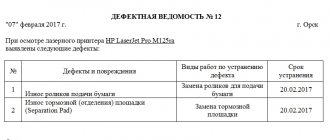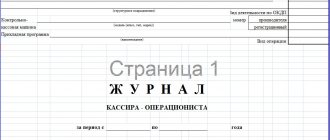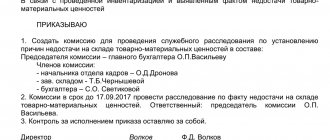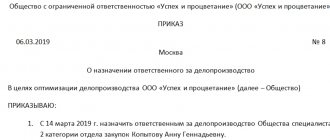In construction, volumes of work often unexpectedly arise that were not previously taken into account by the design and estimate. For example, when laying the foundation of a building, the groundwater level turns out to be significantly higher than the design elevations, and under these conditions it becomes necessary to install additional waterproofing of the foundation. In the same case, it may be necessary to strengthen the soil when developing a pit for a foundation or drainage system.
The types of additional work can be very different, but it is impossible to do without them to fulfill the main construction contract. Since such work is not planned for the project, and financing for it is not provided for in the estimate, there must be a basis for drawing up an additional estimate for such types of work. Such a basis is an act for additional work.
Based on this act, the estimated cost of the project increases. An act for additional work is drawn up by an authorized commission consisting of interested parties. Its task is to confirm the fact that full implementation of the main construction contract is impossible without carrying out certain additional work.
Basic provisions of the act for additional work
The basis for such an act is the reasons why all necessary types of work were not taken into account in the initial design and estimate documentation. In addition, the act lists a complete list of works that will need to be performed in addition to the main ones, which are reflected in the documentation.
In addition to the name, date and place of signing, the act includes a list of authorized representatives for drawing up the said act: representatives of the customer and contractor, the chief engineer of the project and a representative of the design organization.
After the full name of the object, there follows a complete list of additional volumes of work that were not taken into account in the design and estimate documentation, indicating the reasons for the work. The reasons should be described in as much detail as possible, but technically concise.
The following are calculations of the cost of additional work performed. The names of the works, their units of measurement, unit cost and total cost are given in tabular form. Further, depending on the form of the act, costs can be listed by item: workers' wages, machine operation, material resources.
Preparation and signing of the document
To draw up and sign the document, a commission is assembled, the composition of which is approved at the legislative level: representatives of each party . Until the parties reach an agreement, the contractor has no right to continue construction work. To avoid a dispute, the contractor must write an appeal to the customer in the form of a letter with information about the need to suspend construction. The condition for such a necessity is explained by Article 663 of the Civil Code of the Russian Federation.
Carefully! The order completion time will directly depend on the duration of negotiations between the parties. The faster the contractor and the customer determine the purpose of the contract being signed, the faster construction of the facility will resume.
The document must be drawn up in two or three copies , depending on the number of parties participating in the transaction. Usually there are two parties: the customer and the contractor, but sometimes a representative of the design organization is added. Then the number of required copies increases to three.
General information
Large investments are involved in construction, but this money is not always enough to fully complete the work under the contract. For one reason or another (often beyond the control of the performers), it is not possible to meet the budget, and the parties draw up and sign an important document - an act for additional work.
The fundamental document is the contract for additional work, which is concluded between the customer and the executor (contractor) for the construction or modernization of the facility. The act refers to this document.
Estimates also play an important role in construction. The procedure for approving estimates and additional costs for construction services is regulated by Art. 743 and 744 of the Civil Code of Russia. The law establishes that the cost of services according to the estimate cannot exceed more than 10% of the total amount. In this case, it will be enough to draw up a report and continue the work process. If expenses exceed a tenth of the budget, you will have to draw up a new estimate.
Abstract for one topic: Certificates of acceptance of services provided (work performed) - 2018
The acceptance certificate for services provided or work performed is the primary document that the customer and the contractor sign based on the results of the provision of services or completion of work. However, the norms of Civil Legislation contain only general conditions on the need to accept the result of work performed (services provided).
We have put together a unique selection in which you can find answers to the questions :
- To draw up an act or not?
- What should be indicated in the acceptance certificate?
- Is it necessary to put a stamp on the work acceptance certificate?
- Is it possible to draw up acts individually?
In addition, from this collection you can find out all the latest changes regarding the form of this document and the procedure for filling it out.
It will become more clear to draw up primary documents in construction, but not always (end) / “Chief Accountant” 09/03/2018
(Commentary to the resolution of the Ministry of Construction and Architecture of the Republic of Belarus dated July 20, 2018 No. 29). Ending. For the beginning see: “GB”, 2020, No. 32, p. 62.
It will become more clear to draw up primary documents in construction, but not always (beginning) / “Chief Accountant” 08/27/2018
Each business transaction is documented with a primary accounting document. One of their types included in the list of primary accounting documents, to which the Law of the Republic of Belarus dated July 12, 2013 No. 57-Z “On Accounting and Reporting” (hereinafter referred to as Law No. 57-Z) refers (clause 3 of Article 10) , is the acceptance certificate for completed construction and other special installation work. Resolution of the Ministry of Construction and Architecture of the Republic of Belarus dated April 29, 2011 No. 13 (hereinafter referred to as Resolution No. 13) has long ago approved the forms of acceptance certificates for completed construction and other special installation work. However, before the adoption of the Instruction on the procedure for applying and filling out forms of acceptance certificates for completed construction and other special installation work, approved by the commented resolution (hereinafter referred to as Instruction No. 29), any procedure for their preparation (execution, filling out) was not approved.
Let's consider the key aspects of the procedure for drawing up, executing and filling out construction and installation works acceptance certificates.
Forms of construction work acceptance certificates: apply and fill out correctly / News 08/09/2018
In Belarus, the procedure for applying and filling out forms of acceptance certificates for completed construction and other special installation work has been determined. The instruction, approved by Resolution of the Ministry of Construction and Architecture of the Republic of Belarus dated July 20, 2018 No. 29, came into force on August 10, 2020.
Acceptance certificates for services provided (work performed): we will issue them correctly / Current comment 07/30/2018
The acceptance certificate for services provided or work performed is the primary document that the customer and the contractor sign based on the results of the provision of services or completion of work. The certificate confirms that the services have been provided or the work has been completed, and the customer has no complaints about their quality.
We will draw up an acceptance certificate for construction work without stamps / News 05.10.2018
Props "M.P." excluded from six forms of primary accounting documents in construction, including acceptance certificates and transfer acts. Forms have become simpler and shorter.
As of May 9, 2020, the following forms will not be stamped.
You can work without printing / Current comment 11/28/2017
(Commentary to certain norms of the Decree of the President of the Republic of Belarus dated November 23, 2017 No. 7)
The President of Belarus signed Decree No. 7 dated November 23, 2017 “On the Development of Entrepreneurship” (hereinafter referred to as Decree No. 7), which should improve the business climate in the country. The effect of Decree No. 7 covers areas in which the bulk of the country's small and medium-sized businesses are concentrated.
Write-off of an investment property / Question and answer 07/07/2017
Disposal of investment real estate as a result of write-off (in case of physical wear and tear, loss (death) due to emergency circumstances, etc.) is formalized by an act of write-off of property (clause 16 of the Instructions for accounting of investment real estate, approved by the resolution of the Ministry of Finance of the Republic of Belarus dated April 30 .2012 No. 25).
Liquidation of an organization: how does writing off assets affect taxation? / “Chief Accountant” No. 22-2018
When an organization is liquidated, assets may remain on its balance sheet that are physically impossible to transfer to the owner (participants) of the organization after completion of the liquidation. For example, such assets may include intangible assets (hereinafter referred to as intangible assets), construction costs, etc. Is such a write-off taken into account for tax purposes and at what point? Let's answer this question using the example of a single situation.
Use of materials when performing work: sales or own consumption? / “Chief Accountant” No. 22-2018
In some cases, when performing work or providing services, the contractor uses its own materials. Is it possible to include in the acceptance certificate of work performed (services rendered) the cost of the materials used at accounting prices or should a technical specification be issued for these materials to the customer? If you write out a sales tax, what VAT rate is indicated in it and is this not considered a sale? Is it necessary to mark up these materials? Let's answer these questions.
Construction acceptance certificates without stamps and codes / “Chief Accountant” No. 19-2018
Props "M.P." excluded from 6 forms of primary accounting documents in construction, established by Decree of the Ministry of Construction and Architecture of the Republic of Belarus dated April 29, 2011 No. 13. In addition, the forms have become shorter and simpler.
Report on types of economic activities: important details that will help you draw it up correctly / “Chief Accountant” No. 12-2018
(Commentary to the Belstat resolution of October 27, 2017 No. 134)
Features of taxation when carrying out activities through a permanent establishment / “Chief Accountant” No. 12-2018
Construction of a retail facility is underway on the territory of the Republic of Belarus, the general contractor of which is a resident of the Russian Federation. What are the specifics of taxation when working as a general contractor in the Republic of Belarus?
How to determine the date of acceptance of goods for accounting and exclude the recognition of the operation as not economically justified? / “Chief Accountant” No. 7-2018
The date of acceptance of goods for accounting in some cases is of significant importance: it affects the cost of goods received, the amount of tax payments paid, etc. Its incorrect definition can lead to distortion of accounting information. The author explains how not to make a mistake in determining the specified date.
How to correctly draw up acceptance certificates for services provided (work performed)? / “Chief Accountant” No. 31-2016
Upon provision of services or performance of work, acceptance certificates should be drawn up. Based on this document, you have the right to demand payment for work performed or services provided. The certificate of work performed or services provided is also a primary accounting document. Since the form of the act is not approved by law, the author offers recommendations for its preparation.
How to compose correctly
What does a template for an act for additional work look like? By tradition, in case you don’t have a form at hand, we will give general information about the structure that any sample act for additional work has. The form of the act for additional work has four parts:
- Header with a description of the document (name, number, city and date). Here it is also worth referring to the main agreement (write the number and date of conclusion);
- List of commission members (whom they represent, position, full name). This also includes the address of the facility and the reasons for additional work;
- A table with a detailed description of additional work, which includes the numbers of justifications (protocols of the commission’s decisions), names and everything that makes up their cost (material costs, payments to employees, operation of construction equipment). The entire required amount is placed under the table;
- Places for signatures of all drafters of the act and the customer.
The described scheme of the act for additional work is suitable for any purpose. This is what a blank sheet of the act for additional work looks like (we recommend downloading it for your personal collection):
Changes in contractual terms
During the implementation process or as a result of the customer filing a claim at a number of stages, the cost may change relative to the previously signed copy of the document.
For this purpose, an adjustment report for the work performed is drawn up indicating:
- number and date of the document to which the adjustment is being made;
- changes in the pricing policy upward or downward with reference to circumstances, including a defect identified by the customer after signing the main act and accepted by the contractor;
- new total cost according to the changes made.
The date of signing by the customer is the basis for recording and adjusting the VAT amounts relative to what was previously accepted and reflected in the accounting registers by both parties to the transaction.
How to fill it out correctly
You will never have to fill out an act alone (except for very low-budget projects) - this is the task of a whole commission of specialists speaking from both the customer and the contractor.
However, the table must provide a detailed and at the same time visual analysis of costs, so its structure must be thought out depending on the specifics of the services. A universal and effective solution is to allocate two lines for each additional work: unit of measurement and quantity, and in the columns with prices enter coefficients per unit (for example, per square meter of finishing; cubic meter of cement mortar, etc.)
What to pay attention to
Since the main part of the act is a summary table of additional work, the main attention should be paid to its structure and wording. Remember that the purpose of the table is not to justify the need for tasks, but to describe their cost in as much detail as possible, so the only requirement for it is clarity. One glance should be enough for the customer to understand what the costs are.
There is no point in making the table all-encompassingly detailed if this comes at the expense of understanding. Limit yourself to two lines for each task so that the customer sees both the total cost and the price per “unit of work.” For general convenience and to avoid disputes, add at the end of the act the terms and conditions for transferring money for additional work.
The form was prepared using legal acts as of January 22, 2010.
Appendix No. 4 to the contract No. ___ dated "___"________ ___ PROTOCOL OF CHANGES in the scope of work _________________ "___"________ ___ ________________, hereinafter referred to as the “Customer”, represented by ________________, acting___ on the basis of ________________, with one the parties, and ________________, hereinafter referred to as the “Contractor”, represented by ________________, acting___ on the basis of ________________, on the other hand, by this Protocol agreed on the following changes: 1. Cancel the following types of work: ________________, in total in the amount of ______ (________________) ______. 2. Include in the list of works to be performed under the Contract, additional work: ___________________, in total in the amount of ______ (________________) ______. 3. Taking into account the agreed changes, the total price of work under the Agreement from the moment of signing this Protocol is ______ (________________) ______. 4. Due to changes in the volume of work, the duration of the _________ stage of work increases/decreases by ______ days. SIGNATURES OF THE PARTIES: Customer: Contractor: ____________________ _____________________ M.P. M.P.
If the scope of work has changed
Often during construction and installation work there is a need to adjust the scope of work. How to submit additional work? At what cost to accept the object?
The terms of the agreement have been amended
A clause is included in the construction contract: one of the conditions for clarifying the contract price may be for the customer to make changes to the project that increase (decrease) the cost of work under the contract in base prices of 2001 by more than 5 percent. In this case, only the cost exceeding 5 percent is included in the increase (decrease) in the contract price. That is, additional work up to 5 percent that occurs during construction (repair) is not paid for by the customer. How to formalize work completed and accepted by the customer, but not paid for, in forms No. KS-2 and No. KS-3? What cost should be indicated in the act of accepting the object and putting it on the balance sheet (taking into account additional work performed but not paid for or without it)?










